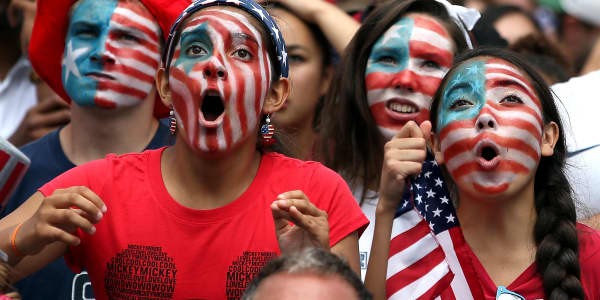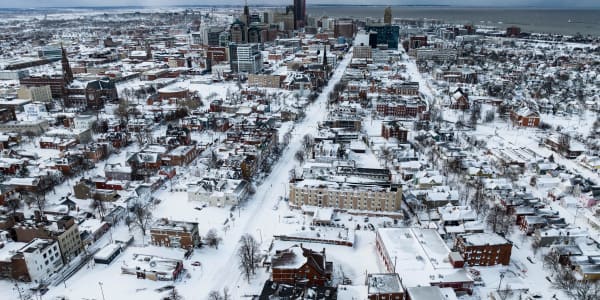How sweet it is! Utah, known as the Beehive State because its people are so industrious, proves its point with a convincing win in our 10th annual Top States for Business ranking.
In many ways, this is the culmination of a decade of hard work by the people and businesses of Utah, developing innovative industries, a skilled workforce and a critical mass of companies big and small that is now rivaling Silicon Valley.
It's not surprising that unicorns like Qualtrics and InsideSales.com are emerging in Utah as venture capitalists flock to the state to invest in a wide variety of industries — from energy and software to medical device companies.
Lured by factors such as tax breaks, affordable real estate, an educated populace and a strong public-transit system, many iconic companies have set up home bases in the state. They are attracted to the pipeline of STEM workers from such schools as Brigham Young University and the University of Utah.
The Top States for Business scorecard tells the story. Utah blows past the competition, with 1,598 out of a possible 2,500 points. But even more impressive is the state's all-around long-term performance. Never before in our 10 years of keeping score has a state finished in the top half in each of our 10 categories of competitiveness.
As always, we score all 50 states on more than 60 metrics across those 10 categories. Under our tried-and-true methodology, we assign a weight to each category based on how frequently the states use them in their sales pitches to business. The state with the highest overall point total takes the Top State title.
This year's categories and point totals are:
- Workforce (400 points)
- Cost of Doing Business (350 points)
- Infrastructure (350 points)
- Economy (340 points)
- Quality of Life (325 points)
- Technology & Innovation (250 points)
- Education (200 points)
- Business Friendliness (160 points)
- Cost of Living (75 points)
- Access to Capital (50 points)
Utah's win caps a success story that exemplifies the state's industrious nature. It has always been a competitive state — this is Utah's eighth top-five finish in 10 years. But four years ago, led by Republican Gov. Gary Herbert, the state set out to be a true champion.
"My goal is to accelerate private-sector job creation of 100,000 jobs in 1,000 days," Herbert told legislators in his 2012 State of the State speech.
At the time, Utah was already outpacing the nation in recovering from the Great Recession. Even so, 80,000 Utahans remained out of work; creating the last 100,000 jobs took seven years.
But by the time Herbert's thousand days were up, in October of 2014, Utah had not only added 100,000 jobs, it tacked on 9,000 more for good measure. The increase probably had little to do with any particular policy initiative by the governor, who primarily vowed to stay out of the way and let the economy do its thing. The economy certainly held up its end of the deal.
My goal is to accelerate private-sector job creation of 100,000 jobs in 1,000 days.Republican Gov. Gary Herbert
Utah is abuzz with business activity. Economy is the state's strongest category in our study, ranking No. 3 with good reason. GDP grew 2.8 percent last year — the third-highest rate in the nation. Consumer spending is strong, and we found the housing market to be among the nation's healthiest.
A key to Utah's success is its robust technology sector, concentrated in the area in and around Salt Lake City that has come to be known as Silicon Slopes. The branding campaign is aimed at helping Utah tech companies share knowledge and resources and attracting capital to the region. On the latter point the state has some work to do.
Utah finishes 24th for Access to Capital, its worst category. Utah businesses attracted an impressive $732 million in venture capital last year, according to the National Venture Capital Association, placing the state in the top tier nationally. But small-business lending lags the rest of the country. It does, however, outpace most of Utah's neighbors.
To be sure, the economic expansion in Utah has not been without critics. Gov. Herbert, seeking his second full term as governor this year, beat back a Republican primary challenge last month by Overstock.com CEO Jonathan Johnson, who accused Herbert of trying to pick winners and losers instead of empowering business as a whole.
In the general election, Democrat Mike Weinholtz, chairman of the privately held medical staffing firm CHG Healthcare Services, has criticized the quality of the new jobs.
"Gov. Herbert likes to tout the number of jobs that we have, but we don't have enough high-paying jobs that pay a living wage," Weinholtz said during a recent campaign appearance.
Average hourly wages in Utah are slightly below the national average. A little more than 3 percent of the workforce is paid at or below the federal minimum wage, according to the latest figures from the U.S. Bureau of Labor Statistics. That is in line with national trends. But because our study measures states from a business perspective, low wages — to the extent Utah has them — count in the state's favor.
A longer-term concern is keeping up with the demand for skilled workers. Utah finishes a respectable 12th in our all-important Workforce category. But within that category, state workforce development programs have shown relatively poor results. In Education, a traditional weak spot, Utah improves to 23rd place from 31st in 2015, thanks in large part to increased funding.
And while Gov. Herbert can hardly be considered a friend to the LGBT community, he nonetheless signed a landmark antidiscrimination bill into law last year. That helps Utah move up to 13th place for Quality of Life.
Familiar territory
Runner-up Texas finds itself in a bit of a rut, but there are worse problems to have. This is the Lone Star State's fourth consecutive year in second place following Top State wins in 2008, 2010 and 2012. In fact, Texas has never finished below second place.
As always, Texas' biggest strength is its economy — the top-ranked in our study. That is especially impressive this year, given the collapse in oil prices. By all accounts, the state learned some tough lessons about diversification during the last oil shock, in the 1980s. While energy remains the state's most important sector, it is no longer the only game in town. With the help of industries like health care and a technology sector that didn't even exist in the '80s, Texas has managed to shrug off the oil glut with only a modest drop in growth.
Texas also boasts the nation's second-best Infrastructure, with two major international airports, one of the world's most important seaports, an extensive rail network and roads and bridges that are in better shape than those in the rest of the country.
But Texas falls short in education, where the situation is only getting worse. The state ranks 40th in the category this year, down from 28th place a year ago. Funding at all levels is lagging the rest of the nation, and high school test results are poor.
Texas is also grappling with serious Quality of Life issues, dropping to 37th place in the category. The state stubbornly remains the most uninsured for health care. It is also among the least inclusive, with no statewide protections against most discrimination.
Rest of the best
States rounding out the top five include third-place Colorado, which captures the coveted honor of the nation's top workforce. Colorado workers are the nation's most educated, and state worker-training programs are among the best performing in the nation. The state is rewarded with one of the best net migration rates in the country.
Minnesota, last year's top state, drops to fourth place this year. The North Star State maintains its advances in Education — where it finishes second — and Quality of Life, where it rises to second place from third place last year. But high costs, including high taxes that Minnesota rationalizes based on the value of the services they buy, are starting to hurt the state by dragging down its economy — and its Top States ranking.
Our fifth-place finisher may raise some controversy, which is something North Carolina is growing accustomed to these days. But the ranking clearly illustrates the cost-benefit analysis the Tar Heel State is facing.
North Carolina's deeply divisive public accommodation law, known as H.B. 2 and which restricts transgender people's access to public restrooms and blocks local antidiscrimination ordinances, has drawn widespread criticism from businesses. There have been calls for boycotts, and some expansions have already been canceled.
It all tends to drown out the state's obvious business advantages, including a solid workforce and a heritage of innovation. And that effect shows up in our numbers. North Carolina ranks 30th for Quality of Life, its worst category, largely because of the non-inclusiveness that is enshrined in state law. More to the point: Were it not for the law, North Carolina almost certainly would have edged out Texas for second place this year and might well be knocking on Utah's door.
This year's most improved state is Michigan, a state that was considered all but hopeless when we began ranking the states a decade ago. The Wolverine State climbs to seventh place overall, up from 22nd place last year.
Michigan owes much of its improvement to a resurgent economy. The state finishes seventh in the Economy category this year, up from 29th place last year. Economic growth ranks in the top 20 percent of the country, and jobs are coming back after a long period of decline.
While Michigan is not as reliant on the auto industry as it once was, the comeback shows just how powerful the state can be when that industry is doing well. That's because the industry doesn't just generate manufacturing jobs, it is also a magnet for innovation. State officials like to point out that Michigan has the nation's largest concentration of engineers, and the state averages one automotive patent every day.
That helps the state come in sixth in our Technology & Innovation category. And in a development that's sure to warm the heart of Gov. Rick Snyder, a former venture capitalist, Michigan finishes fourth for Access to Capital.
Bottom states
If there are top states, there must also be bottom states, and this year's list of laggards includes some usual suspects.
Maine drops to 46th place from 44th last year. Poor infrastructure and a sluggish economy cast a pall on the Pine Tree State, which also finishes with the nation's worst Workforce. Maine's workers are the nation's least productive in terms of economic output per job, and state training programs have shown mixed results.
We have a tie for 47th place: Mississippi and West Virginia are also the bottom two states for Technology and Innovation, and Mississippi has the worst Economy. On a positive note, both sides do well when it comes to costs.
Hawaii, in 49th place, probably has too many built-in disadvantages to ever do well in our study. A state with no rail network is always going to have a hard time competing on infrastructure, but it is hard to argue that a Pacific Island chain needs a rail network. Hawaii's location makes it inherently expensive, though many have argued the state is more expensive than it needs to be. Besides, those costs buy the nation's best Quality of Life — a category Hawaii runs away with yet again this year.
This year's bottom state can't argue any inherent disadvantages, unless you count being small.
With the nation's worst Infrastructure, high costs and poor Access to Capital, Rhode Island is America's Bottom State for Business this year.
Each year, our Top States for Business study sparks plenty of debate and important conversations about what it takes to make a state competitive. Register your comments here, and on social media using the hashtag #TopStates.






